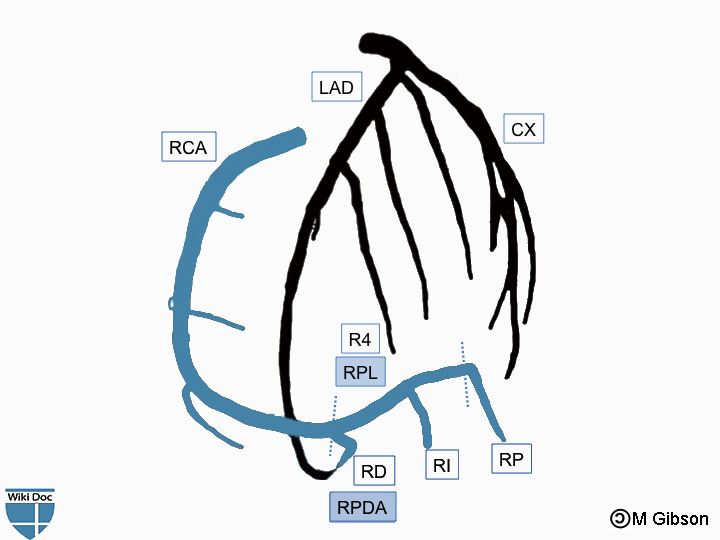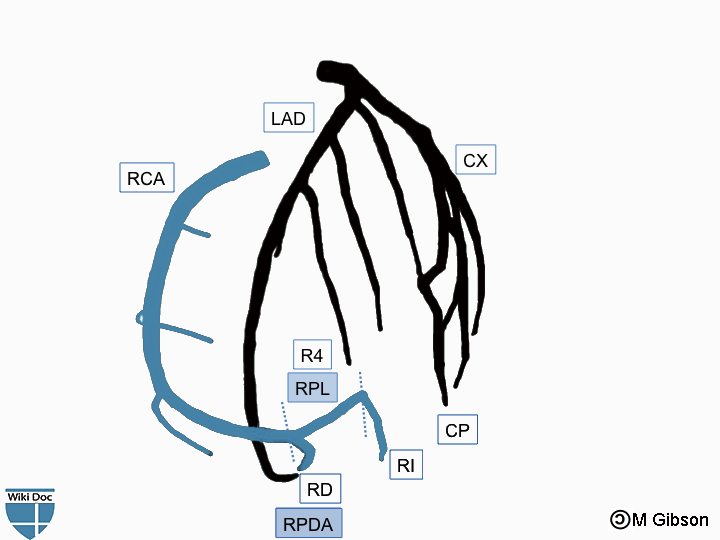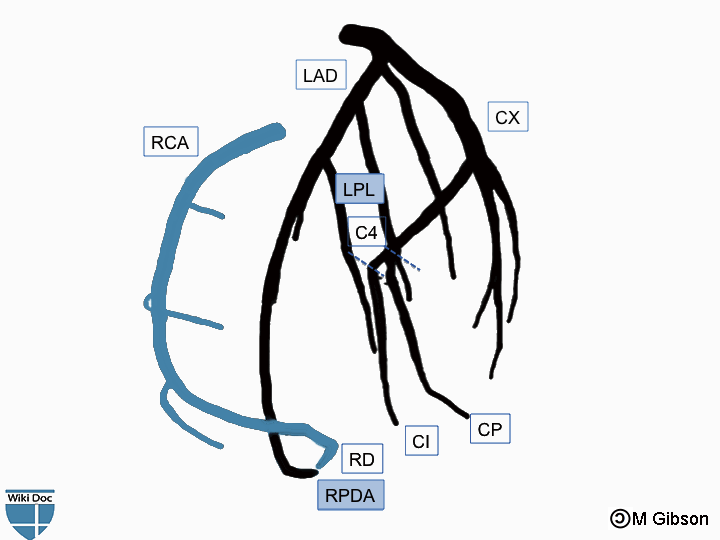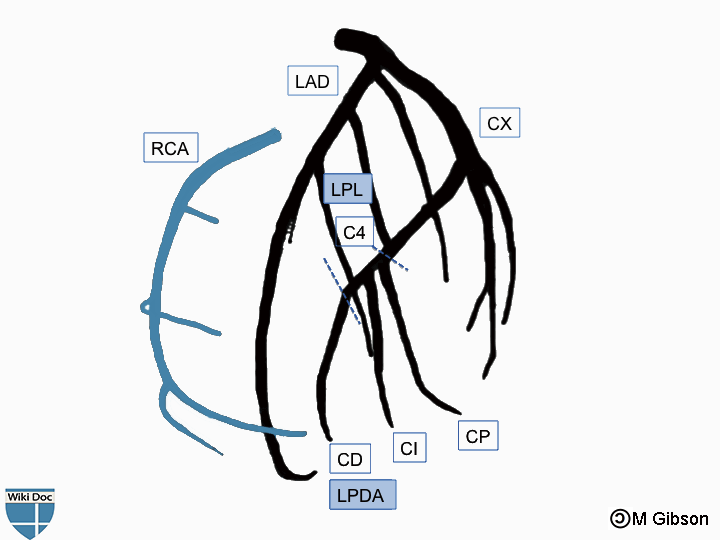Coronary artery dominance
|
Coronary Angiography | |
|
General Principles | |
|---|---|
|
Anatomy & Projection Angles | |
|
Normal Anatomy | |
|
Anatomic Variants | |
|
Projection Angles | |
|
Epicardial Flow & Myocardial Perfusion | |
|
Epicardial Flow | |
|
Myocardial Perfusion | |
|
Lesion Complexity | |
|
ACC/AHA Lesion-Specific Classification of the Primary Target Stenosis | |
|
Lesion Morphology | |
Editor-In-Chief: C. Michael Gibson, M.S., M.D. [1]; Associate Editor(s)-in-Chief: Rim Halaby, M.D. [2]; Hilda Mahmoudi M.D., M.P.H.[3]
Overview
The dominance of coronary circulation is determined by the type of arteries that supply the posterior and inferior wall of the left ventricle. The artery that supplies the posterior descending artery (PDA) and the posterolateral artery (PLA) determines the coronary dominance. Approximately 60% of the general population are right-dominant, 25% are co-dominant, and 15% are left-dominant.[1]
Coronary Artery Dominance
The coronary artery dominance describes how many of the three major branches supplying the posterior and inferior wall of the left ventricle from the right coronary artery (RCA) and how many arise from the circumflex artery (CX). In order to determine the anatomic dominance, the three inferior wall vessels must be specified. There are four types of coronary tree dominance: large right dominant, small right dominant, co-dominant and left dominant.
Large Right Dominance
Shown below is an image depicting a large right dominant coronary artery. A right coronary artery is said to have a "large" dominance when 3 branches arise beyond the distal bifurcation of the right coronary artery (RCA) to supply the septum and the infero-posterior walls. These 3 branches are as follows:
- The right posterior descending artery (RD or RPDA) supplies the inferior septum.
- A branch off of the right posterolateral artery (the right posterolateral artery, RPL or R4 between the two hatched lines) called the right inferior branch (RI) supplies the infero-posterior wall.
- A branch off of the right posterolateral artery (the right posterolateral artery, RPL or R4 between the two hatched lines) called the right posterior (RP) supplies the infero-posterior wall.
CX= Circumflex artery; LAD=Left anterior descending artery; R4= Right posterolateral artery; RCA= Right coronary artery; RD= Right posterior descending artery; RI= Right inferior artery ; RP= Right posterior artery; RPDA= Right posterior descending artery; RPL= Right posterolateral artery. For a full description of the labels, please see the table at bottom of the page.
Small Right Dominance
Shown below is an image depicting a small right dominant coronary artery. A right coronary artery is said to have a "small" dominance when 2 branches arise beyond the distal bifurcation of the right coronary artery to supply the septum and the posterior wall. These 2 branches are as follows:
- The right posterior descending artery (RD or RPDA) supplies the inferior septum.
- A branch off of the right posterolateral artery (the right posterolateral artery, RPL or R4 between the two hatched lines) called the right inferior branch (RI) supplies the infero-posterior wall.
The circumflex posterior artery (CP) arises from the circumflex artery (CX) and supplies the inferior wall.
CP= Circumflex posterior artery; CX= Circumflex artery; LAD=Left anterior descending artery; R4= Right posterolateral artery; RCA= Right coronary artery; RD= Right posterior descending artery; RI= Right inferior artery ; RPDA= Right posterior descending artery; RPL= Right posterolateral artery. For a full description of the labels, please see the table at bottom of the page.
Co-Dominance
Shown below is an image depicting co-dominant coronary artery. A coronary artery is said to have a "co-dominance" or balanced dominance when only the right posterior descending artery (RD or RPDA) arises from the right coronary artery (RCA), while the circumflex inferior artery (CI) and the circumflex posterior artery (CP) arise from the circumflex artery (CX).
C4= Left posterolateral artery; CI= Circumflex inferior artery; CP= Circumflex posterior artery; CX= Circumflex artery; LAD=Left anterior descending artery; LPL= Left posterolateral artery; RCA= Right coronary artery; RD= Right posterior descending artery; RPDA= Right posterior descending artery. For a full description of the labels, please see the table at bottom of the page.
Left Dominance
Shown below is an image depicting left dominant coronary artery. A coronary artery is said to have "left" dominance when the left posterior descending artery (CD or LPDA), the circumflex inferior artery (CI) and the circumflex posterior (CP) artery all arise from the circumflex artery (CX).
C4= Left posterolateral artery; CD= Left posterior descending artery; CI= Circumflex inferior artery ; CP= Circumflex posterior artery; CX= Circumflex artery; LAD=Left anterior descending artery; LPL= Left posterolateral artery; RCA= Right coronary artery; LPDA= Left posterior descending artery. For a full description of the labels, please see the table at bottom of the page.
Shown below is a table listing all the segments of the RCA and LCA in terms of corresponding numbers, labels, locations and anatomic descriptions.
| Segment number | Segment label | Segment location | Segment description |
|---|---|---|---|
| 04 | R4 | Right posterolateral artery | This is the distal continuation of the right coronary artery after the origin of the posterior descending artery. It often has an inverted U shape as described by James and the AV nodal branch originates from this artery. It carries blood to the right posterior and right inferior arteries in large right dominant anatomy, to just the right inferior branch in small right dominant anatomy, and it is not present in left or balanced dominant systems. |
| 8 | RD | Right posterior descending artery | In all but left dominant systems, this vessel runs in the posterior interventricular groove and supplies septal perforator branches. When present, it is one of the three longest branches on the inferior wall of the heart. |
| 9 | RI | Right inferior artery | Arises from the fourth segment of the right coronary artery and supplies the inferior wall. In small right dominant anatomy, it is the distal most branch arising from the right coronary artery, while in large right dominant anatomy it arises proximal to the origin of the right posterior artery. When present, it is one of the three longest branches on the inferior wall of the heart. |
| 10 | RP | Right posterior artery | Distal most branch to arise from the right coronary artery, but present only in large right dominant systems. When present, it is one of the three longest branches on the inferior wall of the heart. |
| 26 | C4 | Left posterolateral artery | In left dominant or balanced systems this is the distal continuation of the circumflex artery in the atrio-ventricular groove. It carries blood to the left posterior descending artery and circumflex inferior artery in left dominant systems and to just the circumflex inferior artery in balanced dominant systems. |
| 27 | CP | Circumflex posterior artery | In all but large right dominant anatomy, this branch originates at the distal end of the third segment of the circumflex at the border of the inferior and lateral left ventricular walls where it traditionally has been called a 4th marginal branch. When present, it is one of the three longest branches supplying the inferior wall of the heart. |
| 28 | CI | Circumflex inferior artery | Arises from the fourth segment of the circumflex and supplies the inferior wall. In balanced dominant anatomy, it is the distal most branch arising from the circumflex, while in left dominant anatomy it arises proximal to the origin of the left posterior descending artery. When present, it is one of the three longest branches on the inferior wall of the heart. |
| 29 | CD | Left posterior descending artery | In left dominant systems this is the distal continuation of the left circumflex artery which travels in the interventricular groove and supplies septal perforators at the base of the heart. This branch is the distal continuation of the circumflex after it leaves the atrio-ventricular groove in left dominant anatomy. When present, it is one of the three longest branches on the inferior wall of the heart. |
Coronary Angiography of the Coronary Artery Dominance
Click here for the standard angiographic views of the coronary artery dominance.



